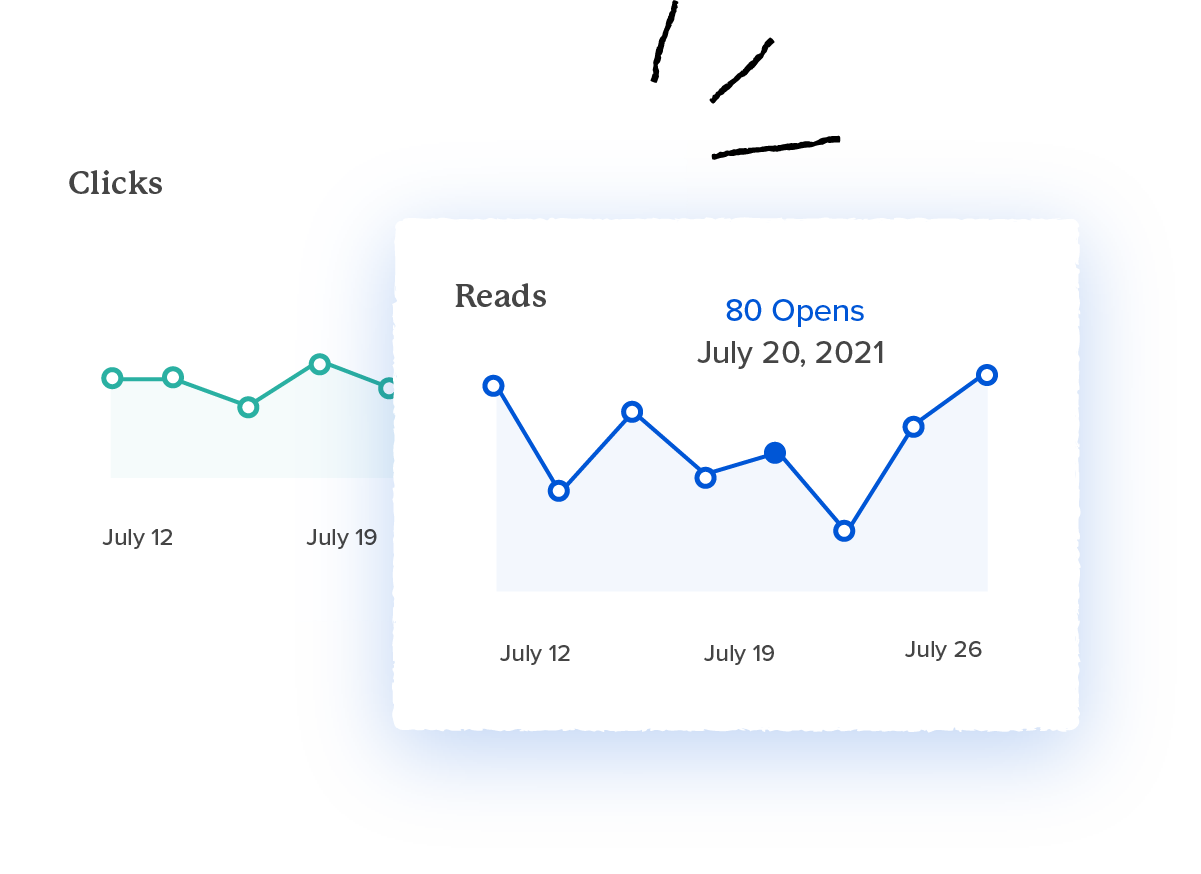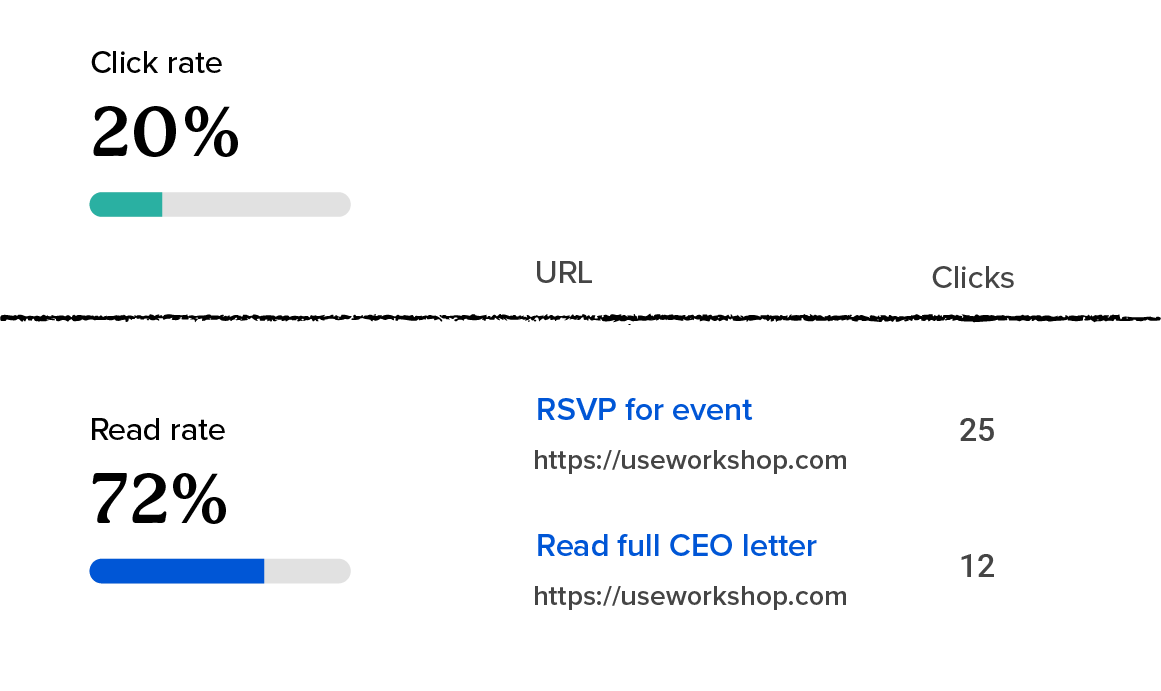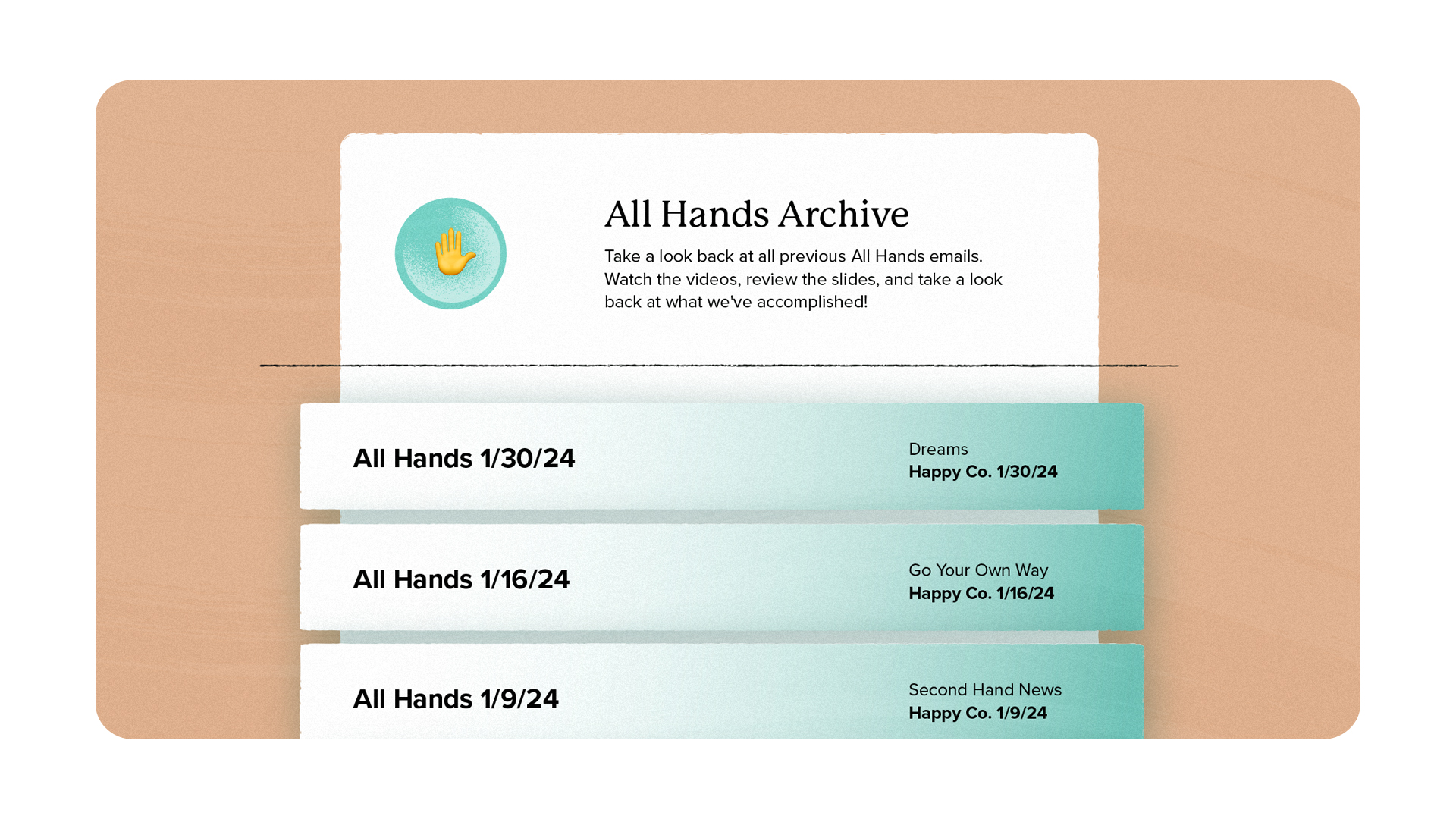The best internal communications metrics to track

Internal comms can borrow from many of the tried-and-true metrics of external marketing, but it also deserves its own unique set of internal communications metrics.
After all, you aren’t dealing with hundreds of thousands of contacts; this audience is particularly unique. This audience is made up of the people you work with every day and the team you’ve built; this isn’t a list of leads, these are your coworkers.
It’s not enough to simply see open and click-through rates, but to see and segment the data in ways where you can truly measure engagement (by role, department, employee, or location).
When it comes to measuring the overall effectiveness of internal communications, it’s most important to select key performance indicators (KPIs) that you can have a direct effect on. While tracking employee engagement data or turnover rates is great, those are indirect measures of your success; there are hundreds of reasons outside of internal communications that could increase or decrease those numbers.
Luckily, there are plenty of internal communication metrics and KPIs that can be tracked and directly tied back to internal communications.
Here are a few of the direct measures we recommend:
- Open rate
- Click-through rate
- Read time
- Engagement data
- Channel effectiveness
- Campaign effectiveness
- Program and event sign-ups
- Traffic to key internal pages
- Employee advocacy
- Internal communications survey results
- Audits and self-assessments
From here, we’ll dig into each metric a bit more deeply, and tell you how you can most effectively measure them!
Direct ways to measure internal communications metrics
These are the metrics that tend to make the best goals and KPIs for any internal communications role. You can directly affect the outcomes of these benchmarks through strategic planning and execution.
Open rate
Our best piece of advice for all internal communications metrics (and marketing metrics, and engagement metrics, and really any metrics for that matter) is this: benchmark against yourself.
It can be really tempting to compare open rates to another organization’s (or an article you read somewhere), but the best thing that you can do is to start measuring your open rates now and measure future open rates against your own data. But the truth is there’s no such thing as universally good internal communications benchmarks. Open rates can vary widely across industries, employee sizes, locations, etc., and you could be chasing a metric that you may not realistically reach.
With internal comms, make sure that your open rates are as accurate as possible. There are two major elements to be aware of:
- Your open rates have likely increased due to the latest IOS 15 update. Apple now pre-loads email data regardless of whether a user actually opened an email, so you might have recently seen your email open rates skyrocket as a result of these changes. Note that those likely aren’t actual email opens. However, once your data has caught up with these changes, we still find that open rates can be a gauge (those perhaps a less important one).
- If you’re sending emails to groups or distribution lists via Outlook, you likely can’t track open or click-through rates accurately at all. Outlook would interpret the email as “one” rather than providing any kind of individual data.
The key here is to make sure you’re using internal email software that is better able to manage your distribution lists and track open rates. With the right tool, not only can you see open rates down to an employee level, but you can also segment your internal communications metrics by role, department, employee, or location.
(And if you truly want some kind of comparison, we often see open rates of 85-90% and click-through rates of 70-75% across Workshop customers.)
Click-through rate
Click-through rate is found by taking the total number of clicks an email receives, and dividing that number by the total number of people who opened that email. With recent privacy measures across Google and Apple properties, it’s become the de facto metric for measuring the effectiveness of email communications.
It can be a bit overwhelming to define the difference between click rate, click-through rate, click-to-open rate, etc. Regardless of what you call it (we call it click-through rate), the correct formula is the one we outlined above. Since the only people who see the messages and links are the people who open the email, it makes sense to measure clicks only based on those who opened the email.
Again, you’ll want to make sure you can see and segment data on click-throughs (which is incredibly easy with the right software).

Time read
As far as email communications go, there can be a tendency to assume that if it’s opened, it’s successful. Many of us are sending mission-critical communications or important company newsletters, and want to know if our audience is just skimming the surface, or really absorbing the content we’ve created. Many tools now offer a way to measure read time, including Workshop, to provide another layer of depth to your team’s internal comms metrics.
You can also use a read time calculator (here’s a free one!) to gauge how long the content should take to read on average, and compare that to your data to see if it’s really being read in depth.

Engagement data
Another distinct advantage to using internally-focused email software is that you can gather engagement data by employee, role, department, location, and more. This information can be incredibly powerful, and give you the ability to spot trends across teams or individuals that you didn’t have visibility into before.
For employee-level engagement data, you can easily see if your message is resonating with its intended audience and know how to follow up effectively: perhaps you need another mass reminder email, or maybe you just need to have a few simple 1:1 conversations.
On a grander scale, you can also spot engagement dips across the organization. Workshop’s advanced analytics, for example, offer a full view of how connected your teams or departments are. Perhaps the engineering team isn’t opening internal emails, or the sales team engages best with emails that are sent on Fridays. You can work directly with those department leaders to continually improve engagement with future announcements.

Channel effectiveness
Of course, email isn’t the only channel for internal communication. Tracking the key metrics of every internal communications channel will enable you to create strategies and plans that deliver your message more effectively in the future.
Here are a few common ones to track for other key channels:
- Intranet: Login numbers, usage time, traffic, clicks
- Slack: Weekly active messages, how many messages were read in public channels, private channels, and direct messages; active members, change in active members
- SMS: Opens, clicks
- Zoom/video: Attendance
- 1-on-1s: Frequency, attendance
Campaign effectiveness
It’s rare that an internal communications effort is done as a one-off or in a vacuum. Often, it’s done as an intentional part of a larger strategy, with a common goal in mind…or, as we like to refer to it, as a part of a campaign. Whether it’s new hire onboarding, open enrollment, CEO updates, events, or product launches, it can be incredibly difficult to stitch together the open rates, click-through rates, channels, and other internal communications metrics to get a birds-eye view of a campaign.
Workshop is specifically built to make this easy, so you can create, schedule, send, and measure complete internal communications campaigns. You can also aggregate data across multiple emails and messages and get a full view of how effective your campaign has been.

Program and event sign-ups
Another example of direct internal communication metrics: track program enrollment and event sign-ups before and after your efforts. It’s a very simple, straightforward way to see your impact on registrations and engagement, whether it’s for a training session, open enrollment, a lunch and learn, or a new company initiative.
Traffic to key internal pages
Just like in marketing, one way to gauge the success of multi-channel communications is to send them all to the same destination. In many cases, this may be an internal landing page, microsite, or intranet post.
The way you can set this up ranges; in a previous company, I set up a password-protected WordPress site, installed Google Analytics on it, and used UTM-tagged URLs to track where employee traffic was coming from.
In a more simpler version, you can simply measure page views, comments, etc. to see if you’re really getting the eyes that you need on that important message!
Employee advocacy
Employee advocacy is the public promotion of a company’s mission, values, brand, and offerings by the employees themselves. It happens organically, and is likely happening in your organization already, without any formal program in place.
The most visible place to find examples of employee advocacy is on LinkedIn. (To be honest, that entire platform is basically a display of official and unofficial employee advocacy programs.) Typically, employee advocacy efforts focus heavily on social media, but we’ve also had success branching the program out into offline channels like events, podcasts, and community-based initiatives.
You can opt for a specially crafted software solution built specifically for tracking and measuring employee advocacy — in fact, here’s a list of them! If you’re in a massive organization and/or your program has truly become that sophisticated, it could certainly be of benefit.
However, we’ve found that you don’t need anything that robust to get started. We’ve experienced a lot of success even with just measuring the program more qualitatively; you’ll find that the senior leadership team (and even the CEO) will be impressed with the stories and engagement that results from the program, and not simply the numbers.
Quantitatively, there are a few measurements you can consider tracking to prove the ROI of a formal employee advocacy program, such as:
- Active participation rate: What percentage of all employees are engaged and sharing company content? What was it before the program launched, and what was it after?
- Top contributors and posts: Who are the employees who share the most often? What posts are receiving the most engagement?
- Website traffic from social media: You can easily track this in Google Analytics to see a general lift and increase in traffic from social media channels in general.
- LinkedIn’s native Employee Advocacy analytics: LinkedIn provides page admins of a LinkedIn Page with a bunch of analytics to gauge trends in employee and member engagement. Here’s how to find that data.
We don’t recommend using any reach or impression metrics; they can feel abstract, over-inflated, and most leadership teams and employees won’t understand what they mean. You can learn more about how to build an employee advocacy program in our full 19-page guide here.
Internal communication survey results
Even if you haven’t been executing on a formal plan, your internal communications have naturally developed in the channels your employees have available to them. Before you tear it all down and build it from scratch, send out an internal communications survey to get a sense of the culture that has already been built around internal communications, and see what is or isn’t working. (We have a template you can use here!)
We recommend sending out this survey every 6-12 months, which will give you a great benchmark and a way for you to measure how effective your efforts have been over time.
Indirect ways to measure internal communications metrics
Outside of all of the above, there are indirect internal communications metrics, such as:
- Employee engagement data
- Progress towards company goals
- Marketing metrics
- Customer success metrics
- Key business metrics
- Turnover and retention rates
Personally, I prefer to look at this data and use it to help shape the focus of our emails and campaigns, and highlight some strong areas of opportunity where internal communications can solve problems and connect teams.
For example, if employee engagement is low in a particular area (like leadership communication), we can work with the leadership team to create a series of more transparent updates or provide more visibility into decision-making at all-hands meetings. Or if the marketing team’s latest product launch has caused more confusion than celebration, we can collaborate with that team to create an internal campaign to better inform and inspire the organization.
Employee engagement data
While internal communicators aren’t directly responsible for employee engagement, the tie is undeniable. Internal communicators act as bridges, connecting employees across different departments, locations, roles, time zones…you name it! Through strategic comms initiatives, you’re able to play an absolutely massive role in building a motivated, informed, and engaged company. Those initiatives tend to include the bulk of the work that internal comms does every day, including leadership communication, timely information sharing, storytelling, change management, two-way communication, etc.
Whether you’re responsible for delivering the employee engagement survey or not, be sure you have access to the full results. You can use this high-level data to drive positive changes and refine your communication strategy. As a result, you may discover new communication channels, content formats, delivery timings, campaigns, feedback opportunities, and more.
Plus, you can place yourself in a much more strategic position by being the go-to source for communicating these results and sharing the insights with key stakeholders, such as leadership and HR!
Progress towards company goals
Most internal communications are designed to help employees better understand and embrace the company’s mission, vision, goals, and objectives.
In fact, internal communications can often make or break the success of an organization. A Fierce, Inc. survey found that 86 percent of respondents blame ineffective communication for workplace failures. When it’s bad, employee engagement and morale can be low, departments can feel siloed, goals and deadlines are missed, and turnover is high. But when it’s great, you can see an absolute waterfall of positive effects: productivity is high, employees are engaged, work flows smoothly, goals are surpassed, and teams feel connected.

Customer success metrics
Happy employees lead to happy customers! If you’re noticing a downward trend in customer success metrics, that’s a signal that you should invest more time and effort into developing content and materials to re-engage that team.
Often, customer support agents are at the front line of our organizations and must bear all the stress that comes with working with a potentially unhappy client. Celebrate stories of employees who went the extra mile to make a customer’s day. and make sure that they feel informed and included.
When you’re working on a shift, it’s easy to miss meetings and memos and watercooler moments. Find ways to reconnect with them through other efforts, then watch to see if those customer success metrics start to get better and better over time.
Marketing metrics
This is another department in which a focused internal communications effort can lead to a lift in success metrics.
Not only that, but as we mentioned earlier, internal communications efforts are directly tied to employee advocacy. Your employees are your best brand ambassadors, and can take to their social media channels and/or personal and professional circles to generate positive buzz and excitement about your organization. They can share a new product on LinkedIn, celebrate the latest ad campaign, or even refer customers your way. Don’t underestimate your ability to impact the success of a marketing initiative simply by generating excitement for it internally!
Key business metrics
Communication professionals shouldn’t just focus on overall company goals, but also stay in tune with key business metrics that span all departments: number of accidents or injuries, customer retention rate, revenue, sales cycle time, gross margin, operating income, order fulfillment, quality, cost, productivity, you name it!
Though it may be tempting to think that you’re “too far” from impacting those numbers with communications, they can actually represent results that are driven in large part by the way communication is managed (or mismanaged).
In many cases, internal communications is able to find the source of the breakdowns that directly cause underperformance, eliminate the root cause, and drastically improve a core business metric as a result.
Employee turnover and retention rates
When employees feel like they’re “in the know” and connected to the company, they feel a greater sense of respect and trust.. If that’s missing, then employees start to feel disconnected and disengaged. This reduces productivity and could eventually lead to employee turnover.
Though employee turnover is certainly not a direct measure of the effectiveness of your internal communications, it can signify a problem that your efforts could potentially help solve!
How to start tracking your internal communication metrics
The following metrics (and more) come built-in to Workshop’s internal communications email platform.
- Open rate
- Click-through rate
- Read time
- Engagement data
- Channel effectiveness
- Campaign effectiveness
- Program and event sign-ups (registrations coming soon!)
The next step:
Learn more about Workshop and request a demo here!








